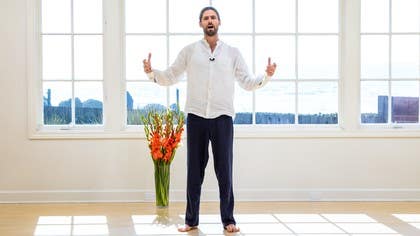Description
About This Video
Transcript
Read Full Transcript
So, in the sixth sutra, Patanjali has listed these five vrittis, pramana, viparaya, vikalpa, nidra, smithayaha. So we have pramana, the first one, viparaya, the second, vikalpa, the third, nidra, the fourth, and the fifth, smithi. And the sixth sutra, the smithayaha, is because they've become a plural compound words, that's just the plural ending. So now, starting with the seventh sutra, Patanjali starts to define these five classifications of vritti. And this is a very beautiful thing that we see throughout the sutra.
When Patanjali introduces a term, very often he will give a very clear definition of it. So first, pramana. Now the word pramana is a very significant word in a shastra or a particular philosophical shastra where systems of knowledge are being set forth. Because pramana means the means of valid knowledge. So here we see Patanjali's genius as a sutra-kara, one who writes sutras because he's doing two things at once here.
One, he is defining the first of these vrittis that he's mentioned, but he is doing two jobs at once. He's not multitasking. He is stacking. I'm going to talk more about this as we get into the teaching, but he's doing two things at once. Well, he's doing many things at once because he's such a genius.
But in an Indian system of philosophy, right at the beginning, it's customary and helpful that the person who's setting it out will basically lay down what are the means of valid knowledge or understanding that are accepted by this system. Different systems accept different things. In the so-called Charvaka philosophy, which is basically materialist philosophy, the only means of knowledge they accept is direct perception through the senses for the out-and-out hardcore materialists. Now, to my mind, this is rather irrational. When I was a young teacher, my first professional teaching job, well, that's not true.
My first full-time job after university was in Japan, and I had a very good friend, and we would go to the same Japanese language class every Wednesday. My friend, he prided himself on being a very rational person. One time we were having this conversation, and I remember saying to him, but if you're irrational, then surely you have to admit that human beings are irrational, because you don't have to look far to see a human doing something that is not rational at all. Humans do this all the time, and he acknowledged this. And if we only accept as real that which can be seen or felt directly with the senses, it's like we're shutting the door on vast areas of human experience, because even the most dyed-in-the-wool, out-and-out, hardcore materialist, if you push them, they will admit that they have feelings that they cannot see or quantify.
And such people in the throes of passion may perhaps exclaim, God, even though they swear such a thing, entity, doesn't exist. But the basic point here is that different schools of philosophy admit different means of knowledge, and yoga accepts three. And this is what Patanjala does here in the seventh sutra, pratyaksha, anumana, agama. These three are the pramanas or pramanani in the plural. So pratyaksha means direct perception.
So in yoga, like pretty much every school of Indian philosophy, direct perception through one's own conscious system, through one's own senses, is a means of valid knowledge. So I see it, I touch it, I experience it, I can know it's real. But yoga also admits anumana. Now anumana means basically inference. Anu, that prefix, means following, mana.
It's related to the word manas, man, which has been considered, contemplated, experienced. So this is basically an understanding that follows from the direct experience of something else. It is inferred, but not experienced directly. So the classic example is we look out to the mountain and we can see smoke. We cannot see a fire, but we can see smoke.
And so the inferential understanding is there is a fire on the mountain, even though I cannot see it, but I can see the smoke. However it's important to notice, to note here, that even though, potentially admits anumana, anumana actually rests on pratyaksha. The inference rests on a direct perception. I directly perceive the smoke and so I infer the fire that is universally concomitant with the smoke. But inference is important for yogic exploration and understanding because a lot of the time we are seeking to kind of expand the depths of our understanding.
So inference can be helpful as we go along that type of path. And the third means is agama. Now agama sometimes gets referred to in other schools of philosophy as shabda, which means that which is spoken. Agama literally means that which has come. So the whole body of tantric literature that has been handed down is referred to as agama.
And agama, it's an authority which has been set down, which has been spoken, which has been shared, and which is also valid. So potentially accepts, yoga accepts, direct perception, inference, and reliable testimony which has come from where, from somebody who had the pratyaksha, who had the direct perception. So even agama also stands on pratyaksha. Somebody had the direct experience and then they set it down in a form that can be perhaps useful for other human beings. So the yoga sutra is itself for us an example of agama.
Ultimately he had the direct experience of yoga, and then he has set it down in this linguistic form that is useful for other human beings. And we can work with it. We don't accept it blindly, but we can use it as a map. We can use it as a guide. We can use it as a frame.
Potentially himself will say that ultimately to really fully understand things at the sattest level there's no map. You have to do that with your own direct experience. But along the way, a map and compass can be very helpful. And to illustrate this, sometimes people say, well I'm not sure about this, how can I rely on somebody else's testimony? So often these things get skewed and colored by political designs or various conditionings.
And this is certainly true. But the sense of agama, it has come. So imagine that you are for example climbing a mountain. Your friend is climbing ahead of you. You realize you've just dropped something.
But your friend has got a better vantage point. So your friend who's further along on the path, you can ask him or her, can you see? Is it that way or that way? Which way do we need to go back? And from their higher vantage point, they can perhaps guide you and you trust them.
You've been walking with them. You know that their eyesight is reliable. If they can see it, you can perhaps go in that direction. You can trust them. And the idea is you can also work together.
So agama means we can help each other. It's not just that I have to experience it only for myself. If my friends are experiencing it, okay, it might give me the idea. This is worth me exploring. I don't have to take their word for it.
I don't have to accept blindly something that I've read about in a text. But I can look at the text. I can feel it makes a lot of sense. So far all the teachings seem pretty valid. I can put them to the test.
Yeah, they line up with my experience. Maybe it's worth going a little bit further. So agama, yoga accepts Vedic and Tantric texts that have been passed down as being a useful support, as being a helpful means to usher us towards that deeper understanding. That said, Patanjali will later say, when it comes to the actual ultimate state, you've got to experience it yourself. But when we are seeking, when we're exploring, when we're practicing, we can make use of all three means, our own direct experience, inference, and agama, the help and support of reliable authorities.
And of course, reliable authority, we have to take responsibility to process the information that comes from something else, from somewhere else, not that we accept it blindly. But basically, yoga accepts the authority and the input, the guidance of Vedic literature and Tantric literature. But the prime means of understanding and coming to correct understanding, your direct experience and what you can infer from your direct experience. So pramana, as well as being the means of valid knowledge, and in this sutra, Patanjali is kind of setting up what he allows as the means of valid knowledge in yoga shastra. Or rather, he is reporting what is allowed within yoga shastra.
Pramana is also a vritti. It's a way that our awareness can become localized. And so it can happen in life that we're doing something, and we get caught up in it. But it also kind of reduces our awareness. So at this point, I'd like to take recourse to my trusty teaching aid, the bottle.
So here we are, and we're experiencing something. Let it be the bottle. So here I am, and I'm noticing the bottle, and it's a correct perception. It is the bottle. But as I am noticing the correct perception of the bottle, I'm kind of getting caught up in the bottle.
And the experience of the object of the bottle, I'm identified with it. But I'm not identified with the consciousness that is allowing me to recognize it as the bottle. So the idea is you can be experiencing something for what it is, but you're kind of forgetting the underlying enabling conscious essence. You're just having the experience. This is pramana as a vritti.
Then potentially continues, vipariyayo mityagyanam atadhrupa pratishtam. So the next sutra, as well as correct perception, pramana, there is vipariyayam. And this is seeing something as it is not, mityagyanam atadhrupa pratishtam. This is when we see something for somebody that it is not. A tat, that, a tat, not that.
So using the bottle once again, imagine you've come into your dwelling place and it's late at night and there is no power, no electricity. You switch on the lights, nothing happens. You're looking around for a candle. Oh, I found a candle. Oh, no.
I thought I'd found the candle. I go to light it, but oh, no, it's a pen, for example. Then you realize, but this doesn't just apply to material objects. Perhaps you've had the experience of thinking something is something that it is not. One of my Sanskrit teachers gave the example of a person who was a diabetic who would say that his pills that would control the sugar levels and the insulin response, these are my life.
And of course, this is just a figurative rendering of the situation, but of course, it's not really seeing the whole picture. There are other things that are also keeping the person alive. So when we have this kind of partial view of something, this is a type of viparjaya. We might also sometimes have the idea, I found the answer. Such a beguiling idea, I found the answer.
Because as human beings, this is what we want here, so much the time. We want things to be easy. And so it can happen with yoga. We can start getting into yoga. Maybe there's a particular style of practice or a technique that really resonates for us.
And we start working with it, and it brings lots of positive benefits. And we think, yes, I found the answer. And what does this signal? This generally signals that we won't be thinking it's the answer for very much longer. Because we thought it was the answer because it was helping us.
Why was it helping us? Because we are really working with it as a means to bring us more fully into the present moment. Because no yoga technique is the answer. The techniques are only means to help bring us a little bit more fully into the present moment. But it's very easy to fall into this trap of thinking, yes, now, now this is it.
But nothing is it. The real yoga practice, the constant steady exploration, the channeling of our awareness with patience and diligence. But it's easy in life to have this misperception. So so far we have correct perception, pramana, as the first vritti. And the second one, vipariya, seeing something in a way that is not quite correct.
Seeing something as something that isn't quite really that. The third of the vrittis, shabdha ghyana nupati, vastu shunyo vikalpaha, is vikalpaha. Now vikalpaha is a wondrous realm. Vikalpa basically means the whole realm of association based on words and language. So if, for example, I say a word, if I say, for example, Ferrari, or I say California, when I say a word like this, chances are that the listener, something might happen in the listener, but if there was a room and there were 50 of us, and I say a word like Ferrari or California or orange, just the word might have an effect within the consciousness of the different listeners, and that effect might be different for every listener.
And the idea is that we might not be in California, we might not have a Ferrari within our field of vision, but just the word can trigger a response because of this capacity of language to carry an associated meaning. And so this vritti of vikalpa includes the whole realm of dream, daydream, imagination, fancy, conjecture. So here we are, wherever we may be. I'm imagining it's not that hard to imagine, because we have this capacity to imagine a situation in which we're somewhere else. We're off somewhere else, we're dreaming, we're planning, this is all vikalpa.
And vikalpa is a very useful thing. But it's also vritti, it's where the powers of our awareness are getting localized in that imagined realm, based on words and their associations. And the next vritti is nidra, abhada pratyalambana vrittir nidra. So nidra is the vritti of sleep. It's the vritti in which the support for our experience is absence.
And the idea is that we actually are cognizant and consciously present to some degree. Because when we wake up from sleep, we can say, I slept well. How can we say we slept well if we weren't actually consciously present to some degree? Or no, I didn't sleep so well. But there is that sleep is this state, this vritti, the state of our awareness, in which it's like the awareness is absent.
This does not just mean the times when we are laid down, eyes closed at night. We could move into the vritti of nidra, of sleep, in the daytime. I hope this isn't happening to you right now. But when you're doing something and you're just, oh, it's off somewhere, and you weren't imagining you were just kind of off. And so this can happen at different points in the day as well as when we're in a deeper sleep.
And then the fifth, anabhuta vishaya sampramoÅ?a smritihi. So smritihi means memory. So sometimes our awareness, the power of our awareness, it gets connected to things in the past. We go into the realm of memory. And this one I'm sure we're all familiar with.
The way he describes it, anabhuta vishaya a sampramoÅ?a smritihi. It's like that which has previously passed, it doesn't recede. It's like you're still connected to it. So what have we got? Seeing something as it is, pramana.
Seeing something as it is not, misperception, viparyayana. The whole realm of associative awareness based on language, vikalpa. Also imagination, dream, projection, planning, fancy. We have the absence of awareness in sleep, which can also be experienced in relatively wakeful states. We're not on the ground, but we're just drifted off.
And then we have memory. So Patanjabi is an amazing genius. All these different ways that the awareness can become slightly fragmented or localized. He's reduced it to these five relatively comprehensive principles. And what is also done, we can also see this, the last one was smritihi in the past.
Vikalpa, if I'm planning for the future, or I'm fantasizing, I'm imagining. So where can our awareness be? It can be in the past. It can be projected outwards. Or it can be in the present, but it's absent in sleep, or it's seeing something localized correctly or seeing something localized incorrectly.
So very, very beautifully, very, very succinctly, potentially has given us an explanation of how and why as conscious beings endowed with this amazing conscious power, we have these limiting ideas because it's altogether natural. We experience through this bodily vehicle that is itself made of the changing stuff of nature. And we have these experiences that can kind of fragment and localize our understandings and our ideas about ourselves. So we get into a little bit of a taste for the majesty, the grandeur of Patanjali's genius. He's very, very good at making vast ideas really concise.
So he's told us what is yoga, and he's told us what's happening when we're not in yoga. So what's the next question? Well how to come to yoga then? If this is what happens when the vrittis, the movements of our awareness get carried here and there in their localized fragmenting patterns, how do we overcome that? And this is where he continues.
Yoga Sutras of Patanjali: Start Where You Are
Comments
You need to be a subscriber to post a comment.
Please Log In or Create an Account to start your free trial.











